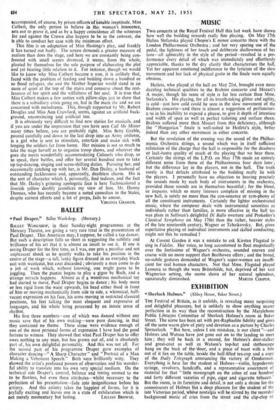MUSIC Two concerts at the Royal Festival Hall this last
week have shown how well the building rewards really fine playing. On May 17th Halina Stefanska played Chopin's E minor concerto there with the London Philharmonic Orchestra ; and her very sparing use of the pedal, the lightness of her touch and deliberate shallowness of her tone—all admirably in the style of the period—resulted in a per- formance every detail of which was immediately and effortlessly appreciable, thanks to the dry clarity that characterises the hall. Yet her apparent emotional indifference to the lyricism of the slow movement and her lack of physical gusto in the finale were equally obvious.
Heifetz, who played at the hall on May 21st, brought even more dazzling technical qualities to the Brahms concerto and Mozart's A major, though his sense of style is far less certain than Mme. Stefanska's. His playing, for all its breath-taking glitter and agility, is cold—just how cold could be seen in the slow movement of the Brahms concerto—and there is almost a suggestion of perfunctori- n.ss in his inability to expand a phrase. to give it depth of intention and width of span as well as perfect tailoring and surface sheen. Brahms suffered more than Mozart from this deficiency, although the " Hungarian " finale is well-suited to Heifetz's style, better indeed than any other movement in either concerto.
But the revelation of the evening was the sound of the Philhar- monia Orchestra strings, a sound which was in itself sufficient refutation of the charge that the hall is responsible for the deadness or lack-lustre quality of much of the playing that we hear there. Certainly the strings of the L.P.O. on May 17th made an entirely different noise from those of the Philharmonia four days later ; but the difference lay in the players, not in the hall. The truth surely is that defects attributed to the building really lie with the players. I personally have no objection to hearing precisely the sounds made by each body of instruments in the orchestra, provided those sounds are in themselves beautiful ; for the blend, or impart°. which so many listeners complain of missing in the new hall, is surely no more than the con-sonance or sym-phony of all the constituent instruments. Certainly the lighter orchestrated music, where the composer deals with instrumental sonorities as individuals rather than families, is more effective in the hall (as was plain in Sullivan's delightful Di Ballo overture and Prokofiev's Classical Symphony on May 17th) than the richer, heavier styles . of the late nineteenth century, Wagner or Tchaikovsky. But, given superlative playing of individual instruments and skilled conducting, might not this be remedied?
At Covent Garden it was a mistake to ask Kirsten Flagstad to sing in Fidelio. Her voice, so long accustomed to float majestically over the fortissimo of Wagner's orchestra, sounded uneven and coarse with no more support than Beethoven offers ; and the broad, un-subtle gestures demanded of Wagner's super-women are insuffi- cient for real human characters. Not that Mme. Flagstad played Leonora as though she were Brilnnhilde, but, deprived of her vast Wagnerian setting, she seems shorn of her natural splendour,


































 Previous page
Previous page